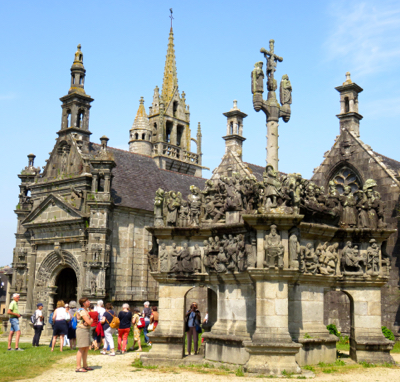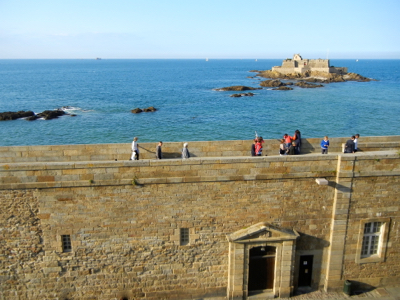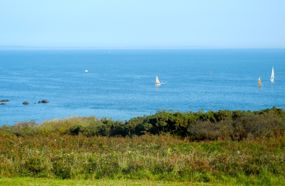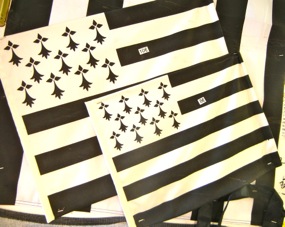 |
Brittany (Bretagne), France | |
| This delightful area of France offers a long and beautiful coastline, a distinctive culture and language, and a long and fascinating history. | ||
|
|
||
|
|
|
Brittany lies in the northwest corner of France (map), a large peninsula with a very long coastline. Known for its wild forests and parks, as well as its history and culture, it's a popular spot for French and international visitors. Brittany, or Breizh in the Breton language, has something for everyone. The great standing stones, or menhirs, of Carnac and surrounding areas date from Neolithic times. Rows of standing stones—older than Stonehenge—evoke Brittany's earliest inhabitants. Just a few kilometers south of Carnac is the beautiful Quiberon Peninsula, with its gorgeous beaches and rocky cliffs, lots of hiking trails, and a couple of small towns with hotels and restaurants. It's also a big center for seafood, and its small port hosts ferries to some of the nearby islands. Go northeast from Carnac and you'll find yourself in Vannes, a lovely medieval port town with interesting architecture and tiny streets. Continue south to Nantes, the largest city in historic Brittany, to see the Château of the Dukes of Brittany, then go north into the forests and you'll find yourself in Josselin, a tiny town dominated by its beautiful château.
Further north you'll come to Quimper, the capital of the Finistère (Land's End) region. Quimper is known for its distinctive and beautiful faience or hand-glazed pottery. Quimper is also a center of Breton culture, and signs in both French and Breton explain major sites. Finistère is also home to the Crozon Peninsula, with its beautiful hiking trails and views of the rugged coastline. Just to the north is the port city of Brest. Farther inland is the town of Morlaix, a small town with a huge railroad viaduct, and a great place to base to visit the parish closes that dot this area. North of Morlaix is Roscoff, where ferries connect to Britain and Ireland.
The Côtes d'Armor department of Brittany, east of Finistére, is home to the lovely seaside town of Perros-Guirec, known for its red granite cliffs and access to the Sentier des Douaniers, Brittany's famous walking trail. You'll also find a number of sites of World War II fame, such as the tiny town of Plouha. Although Mont St-Michel is technically in Normandy, it's right next to the border of Brittany. Mont St-Michel is easily reached from Rennes, the regional capital of Brittany. Also not far from Rennes and Mont St-Michel, on the northern coast of Brittany, is the corsair town of St-Malo. The old walled city of St-Malo is a charming place to visit and enjoy the seaside and the history. Just across the harbor lies the 19th century resort of Dinard. Don't confuse Dinard with Dinan, just 24 kilometers south on the Rance River. Charming Dinan is a beautiful medieval town surrounded by ramparts.
And if you like oysters, make sure to go to the fishing town of Cancale, just 15 kilometers (9 miles) from St-Malo, and 50 kilometers (31 miles) from Mont St-Michel. And speaking of food...Brittany is a center of good eating! Famous for crêpes, cider, and seafood, Brittany also produces delicious pastries and other treats. Throughout its history Brittany has been distinctive, and it was once a separate kingdom. Its language shows the importance of its Celtic heritage. Its folk music, which has enjoyed a revival in the past couple of decades, reflects the history of this fascinating region of France. And there's lots of mythology, including the legend of King Arthur and Merlin. You can even visit "Merlin's tomb" in Brocéliande.
|
|
Above, Coastline near Cancale, Brittany, France.
|




